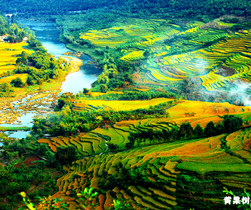Home> Attractions
Ming village fortress
(Beijign today)
Updated: 2007-04-02
Spots to see
Drama stage
The remains of the Jiangnan drama stage lie alongside Donghua Street in Yunshantun tunpu. It is the widest point along the street. There used to be a couplet hanging on both sides of the stage which said, "People's lives are changeab, and everyone's life, no matter who you are, is like a rama."The stage is mainly for festive lantern operas, as well as for chuanju, or Chuan Opera. Locals often invite Chuan opera troupes to perform for a month or two in the village.

Tunpu museum
The Tunpu Museum opened last May. It houses materials, pictures and items to teach visitors about traditional tunpu culture, including folk culture, clothes, food, architecture and tools.
Folk art - Dixi (earth opera)Dixi is a kind of open-air performance enjoyed by the tunpu dwellers. Performers sing, recite, act and fight. Most of the popular operas are about historical stories set before Ming Dynasty, like wars between Chu and Han, the Three Kingdoms period and Fengshen Yanyi, a Ming novel about the battle of celestial beings to seal away evil.
The masks used in Dixi are typical of folk art in central Guizhou. Performers wear the masks on their foreheads, and dress in long gowns and battle skirts, with flags on their backs and weapons in their hands.
Dixi is considered a living fossil of Chinese opera, and has been performed in foreign countries including France, Spain and Japan. There are more than 300 Dixi troupes in Anshun.
What to eat
The tunpu boast a great assortment of truly traditional foods. People eat ciba, gaoba and baoguba made of sticky rice, their main staple. Non-staple foods include preserved ham, sausage, bloodcurd, dried, salty vegetables and dried fermented soybeans. All the foods are perfect for long-term storage.
The food traditions of the tunpu originate from army cooking. Soldiers lived a turbulent life, and it was inconvenient for them to cook. Instead, they salted and smoked vegetables for storage.
Where to stay
There are no hostels in most of the tunpu. Your best bet is to live in Guiyang, capital city of Guizhou, which is not far from the tunpu.
Guizhou Shengfeng Hotel (five star)
Address: No 69, Shenqi Lu, Nanming District
Tel: 0851-5568 888
Price: 540 yuan
Guiyang Lihao Hotel (four star)
Address:No 115, Ruijin Bei Lu
Tel: 0851-6521 888
Price: 398 yuan
Guiyang Ruijin Hotel (three star)
Address: No 62, Ruijin Nan Lu
Tel: 0851-5209 999
Price: 186 yuan
Getting to the tunpu
Most tourists travel to the tunpu from Guiyang. The bus and railway station has buses to Anshun. A ticket is 15 yuan, and it takes about two hours.
In Anshun, take a bus from the stadium stop to Qiyanqiao Town. A ticket will cost about two to three yuan. Qiyanqiao Town has tractors to take visitors to see the Yunshantun tunpu.
To reach the Tianlong tunpu, first take a bus at the stadium stop in Guiyang to Anshun Nan Station. The ticket price is 25 yuan. Next, take a bus to Tianlonglukou for 5.5 yuan.

